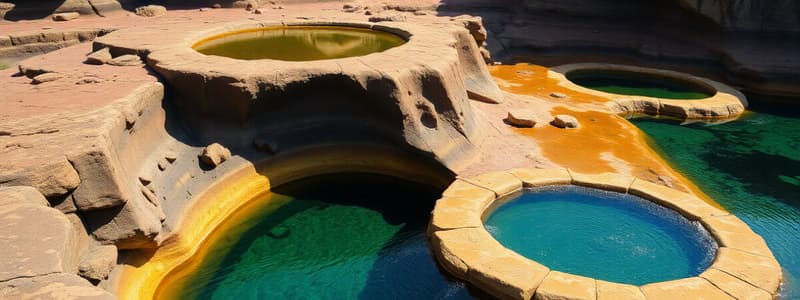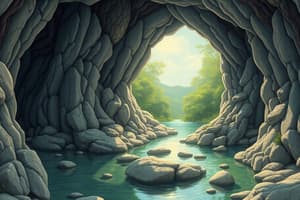Podcast
Questions and Answers
A large natural stream of water flowing over land is called a ______.
A large natural stream of water flowing over land is called a ______.
river
Waterholes, rock holes, and ______ can provide water, combining ground and surface water.
Waterholes, rock holes, and ______ can provide water, combining ground and surface water.
springs
The point where two rivers join is called a ______.
The point where two rivers join is called a ______.
confluence
[Blank] tanks collect and conserve water, but the water may not be safe to drink.
[Blank] tanks collect and conserve water, but the water may not be safe to drink.
Rivers shape the land by carving out ______ and canyons.
Rivers shape the land by carving out ______ and canyons.
Flashcards
Surface Water
Surface Water
Water found on the Earth's surface, like in lakes or rivers; unsafe to drink without treatment.
Spring
Spring
A place where water naturally flows up from underground.
River
River
A large, natural flow of fresh water traveling across the land.
Upper Course
Upper Course
Signup and view all the flashcards
Confluence
Confluence
Signup and view all the flashcards
Study Notes
- Surface water is not safe to drink because it may contain bugs, dirt, rocks, minerals, and/or chemicals.
- Though animals may drink and bathe in surface water, it is not safe for human consumption without cleaning and filtering.
Rainwater Tanks
- Rainwater tanks collect and conserve water but are a form of surface water and can contain contaminants.
- Gutters or roofs can introduce bugs, dirt, and minerals to the water in rainwater tanks.
- This water is suitable for watering gardens, washing cars, or clothes.
- If rainwater is for drinking, gutters should be cleaned and free of leaves/ animal droppings.
Waterholes, Rock Holes and Springs
- These are other sources of available water.
- They combine ground water and surface water.
Rock Holes
- These are surface water features where water is held in a rock or rocky area.
- Rock holes are valuable to Aboriginal people in arid Australia.
- They serve as a crucial water supply in dry landscapes with little permanent surface water.
Springs
- Springs are natural occurrences where water surfaces from an underground aquifer.
- The amount of water flow depends on water pressure in the aquifer, rainfall, and human usage.
- Spring water often appears clear but can be discolored by naturally occurring minerals.
Rivers
- Rivers are natural streams of water flowing over land and are essential to civilization.
- Despite holding a tiny fraction of Earth's total water, they supply the majority of freshwater to people, plants, and animals all across Earth.
- These provide transport, water power, and shape the land by carving out valleys and canyons.
Stages of Rivers
- Rivers are divided into the upper course, middle course, and lower course.
The Upper Course
- Streams form when rain collects in channels in highland areas.
- Streams increase in size and speed while running downhill.
- A confluence is where two rivers join.
The Middle Course
- Rivers erode left and right, forming horse-shoe-like loops called meanders as fast-flowing water causes erosion as they reach their middle course
- Rivers flow down gentler slopes, becoming larger and slower.
- Soil, gravel, and sand sink to the bottom, forming sandbars and islands.
The Lower Course
- A river flows slowly in its lower course across flatland.
- Water force is lower, causing the river to deposit eroded land. Solid material drops and the river enters the sea. The material may build up to form a delta.
Erosion and Deposition of Rivers
- Rivers don't travel in straight lines to avoid obstacles downhill.
- Their courses also change over time.
- These change the shapes of rivers.
- Erosion is when materials like soil or rocks are moved by wind or water, and these materials are called sediments.
- Deposition is when sediments are dropped off in new locations.
River Sediment
- This is carried downstream, causing rivers to often appear brown or murky.
- Sediments from rivers are deposited into lakes and oceans.
Meanders
- The water erodes away at the river's banks until two merge.
- Water will take this newer, short route, not the previous course.
- Deposition of the river's load will block off the older part of the river as time passes.
- This blocking will form an oxbow lake.
Studying That Suits You
Use AI to generate personalized quizzes and flashcards to suit your learning preferences.
Related Documents
Description
Explore surface water sources like rainwater tanks and rock holes. Learn about potential contaminants and the importance of cleaning gutters for safe drinking water. Discover the significance of rock holes for Aboriginal communities in arid Australia.




